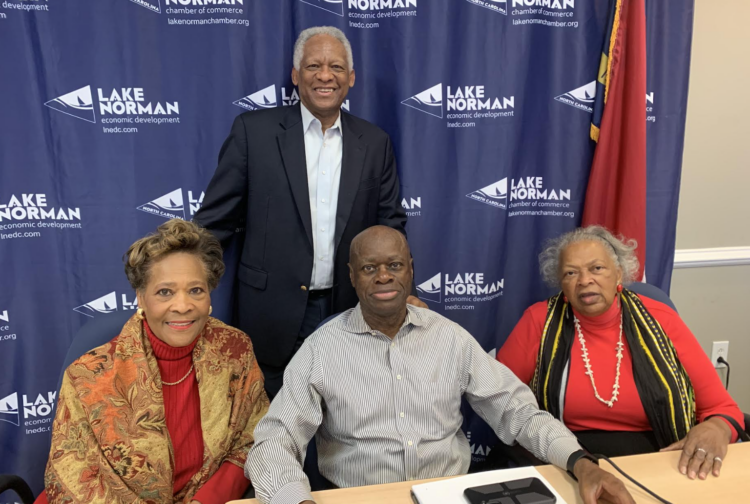
Dan Houston, standing, emceed the Lake Norman Chamber of Commerce diversity council’s discussion with, from left, Ruby Houston, Ron Potts and Betty Caldwell.
March 15. By TL Bernthal. Even with Black History Month celebrations over, there are things anyone can do as a “what’s next” in race relations.
In February, which is Black History Month, the diversity committee of the Lae Norman Chamber of Commerce brought together Ron Potts ,who was born and raised in the Smithville Community, Ruby Houston from Davidson whose passion is to share the life and work of Ada Jenkins for whom the Ada Jenkins Center in Davidson is named, and Betty (B.J.) Caldwell who shares the impact and founders of the Torrence – Lytle High School in Huntersville.
For business leaders, Houston offered this advice: If you have a client who is an African American, ask to listen to their stories.
“They want to tell these stories,” Houston says, “oppression hurts.”
For everyone: Sit down and talk to someone who doesn’t look like you.
The life of Ada Jenkins
The Ada Jenkins name is familiar to most in the Lake Norman area; the Ada Jenkins Center in Davidson was named in her honor. The center offers services including adult and youth education, food pantry, case management and emergency financial support while funds are available.
Ruby Houston never met Ada Jenkins, she met her son and bought the Jenkins home in Davidson; she feels a connection.
Ada Mitcham was born in 1882 to a prominent middle-class African American family in Arkansas. All the children were educated professionals. Ada graduated form Clark University in Atlanta, Georgia. While at college she met Albert G. Jenkins, a student at the Gammon Theological Seminary. The were married in 1906; Ada was 24 and Albert was 34.
They served as missionaries on the West Coast of Africa and returned to the South when to raise a family. They lived in several cities before moving to Charlotte in the 1920’s. in 1930, Albert passed away and Ada moved to Davidson. Ada started teaching at the Davidson Colored School and served as principal for almost 18 years.
During that time, she and others raised funds to build a new brick schoolhouse, which opened in 1937, to replace a wooden school building destroyed by fire. The school closed in 1965, but that brick schoolhouse is the main building of the Ada Jenkins Center.




